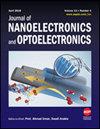Experimental Investigation of Viscosity and Thermal Conductivity of Hi-Tech Therm60 Based BaO Nanofluids
IF 0.6
4区 工程技术
Q4 ENGINEERING, ELECTRICAL & ELECTRONIC
引用次数: 0
Abstract
Nanofluids have drawn a lot of interest lately because of their superior heat transmission capabilities. In order to achieve better heat transfer capabilities, a study on the chemical co-precipitation production of barium oxide (BaO) nanoparticles and its Hi-Tech Therm60-based nanofluid was completed in this work. The effective production of the BaO nanoparticles has been validated by investigations using X-ray diffraction (XRD), scanning electron microscopy (SEM), transmission electron microscopy (TEM), and Fourier transform infrared spectroscopy (FTIR). There were no discernible alterations in the FT-IR spectra linked to the prepared BaO:Hi-Tech Therm60 nanofluids. This suggests that there is no interaction between the created nanofluid and particles. Next The thermal characteristics of BaO: Hi-Tech Therm60 nanofluids, such as their thermal conductivity and viscosity, were thoroughly examined. Measurements were made of the thermal conductivities of the nanofluid at various weight percentages of nanoparticles (0.001%, 0.002%, 0.003%, 0.004%, 0.005%, and 0.006 wt%) at different temperatures from 28 °C to 50 °C. Temperature and weight fraction increases were observed to correlate with improved thermal conductivity of BaO nanofluids. At 50 °C and 0.001 weight percent, the highest thermal conductivity measured was 0.151 W/mK. 10.4 cP was the equivalent viscosity. Compared to the base fluid, it has good viscosity and thermal conductivity.基于 Hi-Tech Therm60 的 BaO 纳米流体的粘度和导热性实验研究
纳米流体因其卓越的传热能力而备受关注。为了实现更好的传热能力,本研究完成了氧化钡(BaO)纳米粒子的化学共沉淀生产及其基于 Hi-Tech Therm60 的纳米流体的研究。通过使用 X 射线衍射 (XRD)、扫描电子显微镜 (SEM)、透射电子显微镜 (TEM) 和傅立叶变换红外光谱 (FTIR) 进行研究,验证了 BaO 纳米粒子的有效生产。所制备的 BaO:Hi-Tech Therm60 纳米流体的傅立叶变换红外光谱没有明显变化。这表明所制备的纳米流体与颗粒之间没有相互作用。接下来,对 BaO:Hi-Tech Therm60 纳米流体的热特性(如热导率和粘度)进行了深入研究。在 28 °C 至 50 °C 的不同温度下,测量了不同重量百分比纳米粒子(0.001%、0.002%、0.003%、0.004%、0.005% 和 0.006 wt%)的纳米流体的热导率。温度和重量分数的增加与 BaO 纳米流体热导率的提高相关。在 50 °C 和 0.001 重量百分比条件下,测得的最高导热系数为 0.151 W/mK。等效粘度为 10.4 cP。与基液相比,它具有良好的粘度和导热性。
本文章由计算机程序翻译,如有差异,请以英文原文为准。
求助全文
约1分钟内获得全文
求助全文
来源期刊

Journal of Nanoelectronics and Optoelectronics
工程技术-工程:电子与电气
自引率
16.70%
发文量
48
审稿时长
12.5 months
 求助内容:
求助内容: 应助结果提醒方式:
应助结果提醒方式:


